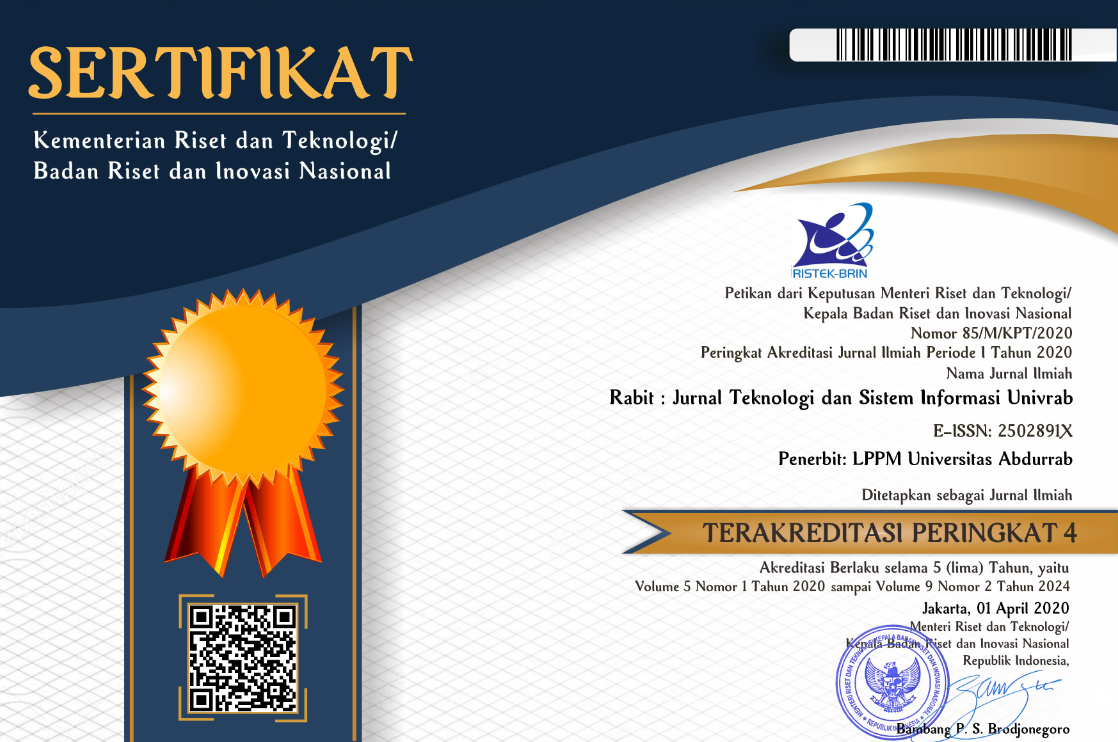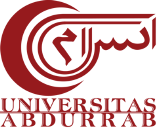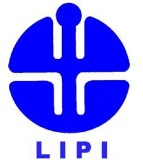ANALISIS KUALITAS WEBSITE SAMSAT JAMBI MENGGUNAKAN METODE DELONE AND MCLEAN
Abstract
The SAMSAT website is an application of information technology that is used to facilitate motorized vehicle users to obtain information related to services provided by the SAMSAT office. Based on the results of the initial questionnaire that the researcher has distributed to 50 respondents, 82% of the respondents stated that the SAMSAT Jambi website has weaknesses, including the website is less attractive in terms of interface and there is an error menu on the website. The purpose of this study is to analyze the level of success of the website SAMSAT Jambi using the Delone and Mclean method and to determine the effect of independent variables (system quality, information quality, service quality) on the dependent variable (use, user satisfaction, net benefits). Data analysis using SEM and SmartPLS software. Based on the results of the data processing of the Jambi community questionnaire, it was found that of the 9 hypotheses proposed in this study, only 7 hypotheses were acceptable including system quality on usage, system quality on user satisfaction, quality of information on usage, quality of information on user satisfaction, use of user satisfaction, use of net benefits, and user satisfaction with net benefits
References
F. N. Zaenal Mustofa, “Inovasi Pelayanan Pembayaran Pajak Kendaraan Bermotor Melalui Layanan Samsat Mini ( Samin ) Di Kantor Bersama Samsat Kabupaten Bojonegoro,” J. Publika, vol. 5, no. 1, hal. 1–8, 2017. [Diakses: 2 Oktober 2019].
D. Mardiana, G. Testiana, and M. Kadafi, “PROSIDING seminar nasional sisfotek Penerapan Model Delone dan Mclean Pengukuran Kesuksesan Simak Online UIN Raden Fatah Palembang,” Penerapan Model Delone dan Mclean Pengukuran Kesuksesan Simak Online UIN Raden Fatah Palembang Dwi, vol. 3584, hal. 47–56, 2017. [Diakses: 5 Desember 2019].
B. P. Bahesa, “Analisis Kesuksesan Sistem Informasi Website Pemerintah Kabupaten Pamekasan Berdasarkan Model Delone and McLean.” hal. 1–109, 2018. [Diakses: 12 Desember 2019].
P. H. Saputro, D. Budiyanto, and J. Santoso, “Model Delone and Mclean Untuk Mengukur Kesuksesan E-Government Kota Pekalongan,” Sci. J. Informatics, vol. 2, no. 1, hal. 1–8, 2016, doi: 10.15294/sji.v2i1.4523. [Diakses: 5 Januari 2020].
D. Y. Siregar, “Pengukuran Kesuksesan Sistem Informasi Keuangan Universitas Atma Jaya Yogyakarta Dengan Model Delone Dan Mclean,” hal 18–36, 2017. [Diakses: 16 Januari 2021].
Moh. Nazir, “Metode Penelitian,” Metod. Penelit., 2014.
D. P. Anggraeni, “Pelanggan ( Survei pada Pelanggan Nasi Rawon di Rumah Makan Sakinah Kota Pasuruan ),” vol. 37, no. 1. [Diakses: 16 Januari 2020].
W. Abdillah and J. Hartono, “Pengaruh Motivasi Kerja Terhadap Kinerja Karyawan Melalui Kepuasan Kerja Sebagai Variabel Mediasi Pada Karyawan Pt . Borwita Citra Prima Surabaya,” Agora, 2017. [Diakses: 16 Januari 2020].
W. Abdillah and H. Jogiyanto, “Partial Least Square (PLS) Alternatif Structural Equation Modeling (SEM) dalam Penelitian Bisnis,” in book, 2015. [Diakses: 17 Januari 2020.
S. Hudananta, T. Haryono, and Sarjiya, “Study of overcurrent protection on distribution network with distributed generation: An Indonesian case,” in Proceedings - 2017 International Seminar on Application for Technology of Information and Communication: Empowering Technology for a Better Human Life, iSemantic 2017.[Diakses: 17 Januari 2020].
W. Abdillah and J. Hartono, “Pengaruh Motivasi Kerja Terhadap Kinerja Karyawan Melalui Kepuasan Kerja Sebagai Variabel Mediasi Pada Karyawan Pt . Borwita Citra Prima Surabaya,” Agora, 2017.

This work is licensed under a Creative Commons Attribution-NonCommercial-ShareAlike 4.0 International License.
Copyright Notice
The copyright of the received article shall be assigned to the publisher of the journal. The intended copyright includes the right to publish the article in various forms (including reprints). The journal maintains the publishing rights to published articles. Therefore, the author must submit a statement of the Copyright Transfer Agreement.*)
This work is licensed under a Creative Commons Attribution-NonCommercial-ShareAlike 4.0 International License.
In line with the license, authors and any users (readers and other researchers) are allowed to share and adapt the material only for non-commercial purposes. In addition, the material must be given appropriate credit, provided with a link to the license, and indicated if changes were made. If authors remix, transform or build upon the material, authors must distribute their contributions under the same license as the original.
Please find the rights and licenses in RABIT : Jurnal Teknologi dan Sistem Informasi Univrab. By submitting the article/manuscript of the article, the author(s) accept this policy.
1. License
The non-commercial use of the article will be governed by the Creative Commons Attribution license as currently displayed on Creative Commons Attribution-NonCommercial-ShareAlike 4.0 International License.
2. Author’s Warranties
The author warrants that the article is original, written by stated author(s), has not been published before, contains no unlawful statements, does not infringe the rights of others, is subject to copyright that is vested exclusively in the author and free of any third party rights, and that any necessary written permissions to quote from other sources have been obtained by the author(s).
3. User Rights
RABIT's spirit is to disseminate articles published are as free as possible. Under the Creative Commons license, RABIT permits users to copy, distribute, display, and perform the work for non-commercial purposes only. Users will also need to attribute authors and RABIT on distributing works in the journal.
4. Rights of Authors
Authors retain all their rights to the published works, such as (but not limited to) the following rights;
- Copyright and other proprietary rights relating to the article, such as patent rights,
- The right to use the substance of the article in own future works, including lectures and books,
- The right to reproduce the article for own purposes,
- The right to self-archive the article,
- The right to enter into separate, additional contractual arrangements for the non-exclusive distribution of the article's published version (e.g., post it to an institutional repository or publish it in a book), with an acknowledgment of its initial publication in this journal (RABIT : Jurnal Teknologi dan Sistem Informasi Univrab).
5. Co-Authorship
If the article was jointly prepared by other authors, any authors submitting the manuscript warrants that he/she has been authorized by all co-authors to be agreed on this copyright and license notice (agreement) on their behalf, and agrees to inform his/her co-authors of the terms of this policy. RABIT will not be held liable for anything that may arise due to the author(s) internal dispute. RABIT will only communicate with the corresponding author.
6. Royalties
This agreement entitles the author to no royalties or other fees. To such extent as legally permissible, the author waives his or her right to collect royalties relative to the article in respect of any use of the article by RABIT.
7. Miscellaneous
RABIT will publish the article (or have it published) in the journal if the article’s editorial process is successfully completed. RABIT's editors may modify the article to a style of punctuation, spelling, capitalization, referencing and usage that deems appropriate. The author acknowledges that the article may be published so that it will be publicly accessible and such access will be free of charge for the readers as mentioned in point 3.
 PDF (Bahasa Indonesia)
PDF (Bahasa Indonesia)
 Abstract views: 757
Abstract views: 757
 downloads: 552
downloads: 552

 :
:












